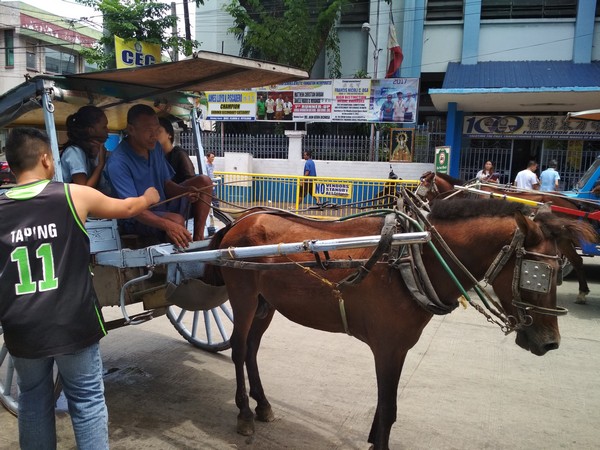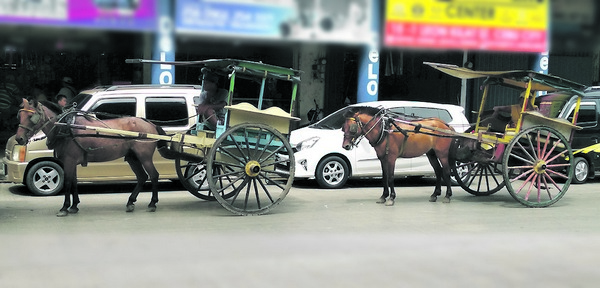First of three parts
Cars rushing by, the honking of horns trying to drown each other, and people running after fully-loaded jeepneys.
These are early morning scenes along Leon Kilat Street, Cebu City as the noise from people and machines blend together in an urban orchestra that is familiar to homegrown Cebuanos.
Every so often, the soft tapping on the asphalt road from a horse’s hooves breaks the urban music as an old tartanilla rolls by.
The tartanilla, also known as calesa in Filipino, is a two-wheeled carriage drawn by a single horse.
It dates back to the Spanish colonization era before motorized vehicles were introduced in 1901, according to a study by Cebu Normal University (CNU).
In the past, the carriages were the jeepneys of the road flaunting creative designs with hand-painted art and drawn curtains.
Ordinary horses were adorned with bards and tacks that made them look like mighty stallions.
“This means of transportation used to be a luxury vehicle among the affluent members of Cebuano society in the past. As time went by … the pasahero’s interest in saving for money resulted in the existence of the tartanilla, “ the CNU study said.
The appearance of the tartanilla originated in the 1930s.
It has a seating capacity of five, including the kuchero (coachman) or paradista (tartanilla owner/driver), who drives the parada (another name for tartanilla), said the CNU study penned by Benita Manugas, Maylen Recto, Denise Meriel Sollano, Reynaldo Inocian, and Rebecca Leslie J. Cabras of the school’s Social Sciences Department.
“The tartanilla in Cebu has festive colors and decorations on its carriage body called the kaha. Painters and carpenters construct these kaha in a manner that resembles the way their ancestors have fashioned it for generations,” the study added.
From the 30’s to the 70’s, the tartanilla proudly trotted in great numbers through Cebu’s major thoroughfares and highways from Colon Street to Sanciangko all the way up to Tabo-an market and Tres de Abril in Cebu City’s south district.

A tartanilla driver transports passengers along Leon Kilat Street in downtown Cebu City.
Today, the tartanilla can take you around Pasil, Tabo-an, and Duljo streets.
University of San Jose Recoletos (USJR) professor Nestor Ramirez, who is currently doing a study to help preserve tartanillas as part of culture, recalls how horse-drawn carriages were once the only form of transportation for Cebuanos as they freely went around the city’s streets looking for passengers.
Barangay Duljo-Fatima has remained the place where a lot of the tartanillas are made and the horse stables are located.
Traffic hazard
According to Cebu City Transportation Office (CCTO) chief Francisco Ouano, only about a hundred tartanillas traverse the streets of downtown Cebu City at present.
Their routes are now limited to Barangays Pasil and Duljo Fatima, and Magallanes Street in downtown Cebu City so as not to hamper the flow of traffic in major streets, said Ouano.
Far from its glory days, the tartanilla of today no longer sports hand-painted art but prefers the subtle colors of yellow and brown.
A lot of the horses used by coachmen are also visibly undernourished and tired.
Cebu City Veterinarian, Dr. Alice Utlang, told Cebu Daily News animal welfare groups are now lobbying for the removal of this mode of transportation from Cebu City streets.
The whipping of the horses, to direct them to go faster, hurts the horses, and is considered by Dr. Utlang as a form of animal abuse.
But to entirely eliminate tartanillas from the city would mean having to erase Cebuano history and culture that go with it, said Utlang.
She believes that as long as there are passengers for tartanillas, the horse-drawn carriages should remain but with better regulation by government authorities.
Among those who still choose to ride the tartanilla over the more popular jeepney, whenever possible, on her way to work is 21-year-old Egine Estorba.
Estorba said that the tartanilla is more convenient for her because it is readily available in Barangay Pasil, where she lives, and the fare is cheaper.
“The tartanilla is affordable. Six pesos only and very comfortable,” said Estorba.
It would take Estorba around 11 minutes to travel from her house to Leon Kilat Street where she would then ride a jeepney to get to her workplace in Banilad, Mandaue City.
The tartanilla, she said, has easily become a part of her daily commute.
Like Estorba, Azil Mae Yburan, 18, a student, is also a fan of tartanillas because of the “easy feeling” of being in one.
She would take the carriage from her home in Barangay Suba to the downtown area to shop for groceries.
“Mao ra man ang madali-dali’g sakay (It’s the easiest to ride),” Yburan said.
Despite its declining popularity, the tartanilla or parada remains on the streets not just as a reminder of Cebu history; but also, as a genuine part of the lives of many Cebuanos who choose to still peacefully enjoy it over the whizzing jeepneys and taxis. / Gerard Vincent Francisco, Delta Dyrecka Letigio and Zena V. Magto, USJ-R Interns
(To be continued…)
Disclaimer: The comments uploaded on this site do not necessarily represent or reflect the views of management and owner of Cebudailynews. We reserve the right to exclude comments that we deem to be inconsistent with our editorial standards.

